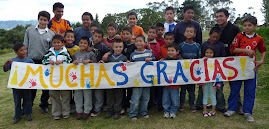Last week, during the school break for
Semana Santa, we started making 50 wooden cars that my son, Keegan, and I plan to take to Haiti later in April. We plan to give the cars as evangelical gifts to kids that we meet there. Each car will have a Bible verse printed on it.
Starting March 29th, the group of five young men cut out the bodies for all the cars and assembled about half of them. We hit some obstacles along the way. But with patience and God's grace, we found ways around them.
The picture below shows the crew that worked on the cars, l to r, Ruben Ruiz, Einer Posada, Keegan Bye, Luis Meza, and William Gomez. They are seated on a few of the eucalyptus blocks that we unloaded from a big truck on Day 2 of the trip.
The first problem came up right after we'd prepared the wood to cut up into car bodies, when we discovered that the scrolling saw had a problem. It made a terrible racket when we turned it on, similar to the noise it makes when you break a blade. But the blade was new and properly adjusted. After disassembling the machine (with no instruction manual or previous experience) we found out that an internal spring was broken. Fortunately it wasn't hard to bend a new end attachment on the spring, but it took three tries to get the machine re-assembled correctly and working properly. We probably spent half of the first day fixing the scrolling saw, but without it we wouldn't have finished any cars this trip, we'd still be cutting out car bodies...
So, Einer Posada and William Gomez took over the scrolling saw and made the sawdust fly! Einer is shown in the picture above, here he's running the cars over a 1/8" roundover bit in the router, but the scrolling saw is shown in the background.
Meanwhile, Keegan and Luis Meza smoothed the bodies with a sanding drum mounted in the drill press and drilled the holes for axles and simulated windows. They made a whole lot more sawdust fly! In the process, we encountered our second problem - the drill bit for the axle holes was dull. So I got the Drill Doctor out and sharpened that bit and many more that were dull in the set. Sure is a blessing to have nice tools!
Einer (nearer) and Ruben (operating press) drilling holes for axles.
Luis and Ruben Ruiz cut the 8mm dowels to the appropriate length, using a Japanese back-saw and a homemade miter box. They quickly cut up all the dowels that we had, which was enough for about 25 cars.
Then we set up the router and roundover bit so that Einer could run them all through, rounding off the sharp edges on the car bodies. Quick - and saves a lot of sanding to make them look so much more finished!
We saved one of the harder and more time-consuming jobs until Day 2, which was cutting out the wheels from 3/4" hardwood. Keegan was the specialist at this job, while Luis sanded off the tearout using the disk sander. It takes 200 wheels to make 50 cars!
Then there is the hand sanding and assembly step. Not as easy as it sounds, because you often have to take it back to a previous step to correct defects. William Gomez and I are the fussy detail-oriented types on the team, so we did most of this job. Hard work!
At lunchtime on March 31st, they had cut out and assembled 25 cars, with another 25 car bodies waiting for wheels, axles, and assembly. We needed more materials and our support staff was itching to get back home, so we called it good for this trip.

















 B
B



























